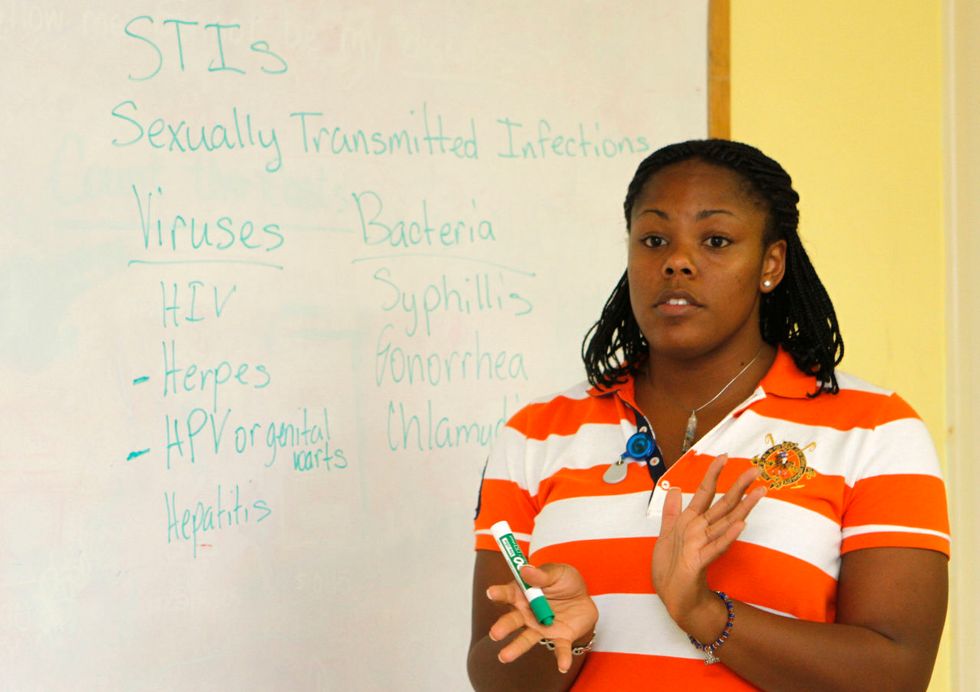The Archives of Pediatrics and Adolescent Medicine reports that 82% of U.S. adults favor a comprehensive approach to sex education that teaches students about contraception and safe-sex, rather than an abstinence-only curricula (Seagren). Despite this demand, the federal government continues to pour millions of dollars into abstinence-only education, which focuses on the consequences of premarital sex, and emphasizes that the only acceptable form of sexuality is between one married man and woman. Many people support abstinence-only education because they believe that abstinence is the only way of preventing pregnancy and that teaching teens about sexual health sends them the message the message that is acceptable for them to have sex. On the other hand, critics of abstinence programs point to the discriminatory nature of these programs and their failure to keep teens abstinent and drive down teen pregnancy rates.
So What Does Abstinence Education Really Promote?
Pregnancy
Firstly, abstinence-only sex education should not be taught in schools because it fails to decrease teen pregnancy rates. According to a study conducted by the CDC, “86% of the decline in teen pregnancies between 1995 and 2002 could be accounted for by contraceptive use, while only 14% was attributable to teens abstaining from sex” (“Teen Pregnancy”). Based on the data collected in this study, it is clear that education about birth control, not abstinence, is what has caused the recent decline in teenage pregnancy rates. Moreover, research by the Guttmacher Institute concluded that the countries with the lowest teen pregnancy rates also have much greater access to information about, and to contraceptives, when compared to the U.S. (“Teen Pregnancy”). This data is significant because it makes a strong connection between low teen pregnancy rates, and education about birth control, which is not included in the abstinence-only curricula. More specifically, the country with nearly the lowest teen birthrate in the world, Sweden, also offers its students some of the most comprehensive sex education programs in the world. For example, the article “Teen Pregnancy” states that “Sweden, in particular, offers very comprehensive sex education to its students, beginning in the earliest grades, proponents note. As a result, they say, Sweden has one of the world's lowest rates of teen pregnancy; the U.S. should learn from that example, they say.” Based on this statement, it is clear once again that a comprehensive sex education approach, rather than an abstinence-only approach, has been the most successful in preventing teenage pregnancy. Lastly, education about condoms and other forms of safe-sex are not discussed within abstinence-only courses, which also fails to lower teen pregnancy rates. This is apparent because opponents of abstinence programs advocate that lower teen pregnancy rates can be attributed to:
The promotion of condoms for protection against AIDS, as well as to the popularity of hormone-based birth control, such as the injectable drug Depo-Provera, among teenage girls. Birth control, combined with sex education, has made a difference in teen pregnancy levels (“Teen Pregnancy”)
According to this statement, comprehensive sexual education, alongside access to condoms and birth control, has lowered teenage pregnancy rates, which argues against abstinence-only education because such programs ignore all discussion around condoms and birth control. To conclude, abstinence-only sex education programs are ineffective when it comes to preventing teen pregnancy, thus, such programs should not be taught in schools.
The Absence of Abstinence
To continue, abstinence-only sex education should not be taught in schools because it does not effectively promote abstinence. This is clear because there are endless studies that have found that students who receive comprehensive sex education wait and longer to have sex than their counterparts who were only taught abstinence education. The same studies have also shown that comprehensive sex education programs made students less likely to have sex under peer pressure, and gave students a more positive outlook on sexuality than students who received abstinence-only sex education (Beh & Milton). Based on these findings, it is obvious that such programs that attempt promote abstinence over safe-sex are not effective in actually promoting abstinence, and therefore should not be taught in schools. Furthermore, a study which examined four different abstinence programs in April of 2007 concluded that “students who took part in them were not likely to wait any longer than other students to begin having sex” (“Teen Pregnancy”). Ironically, abstinence-only programs in fact do not effectively encourage abstinence, thus, they are futile and should not be taught in public schools. Similarly, many abstinence-only programs require their students to partake in “virginity pledges”, which are also ineffective. In fact, the article “Teen Pregnancy” states that students who take these pledges “are more likely than not to break their pledges, and are less likely to use contraception when they do have sex." Therefore, abstinence-only education can not only be ineffective, but hazardous when it comes to teen health by putting teenagers more at risk for pregnancy and contracting STDs. Ultimately, “There is no scientific evidence that abstinence-only curricula in schools are effective, either in delaying onset of first intercourse or preventing pregnancy and STDs” (Roffman). In summary, countless studies and surveys show that abstinence-only sex education is completely ineffective when it comes to achieving what they are meant to, which is abstinence, which is why they should not be taught in school.
Discriminatory and Inaccurate Teachings
Finally, abstinence-only sex education should not be allowed in schools because the curriculum often discriminates against many students, as it relies on inaccurate and fear-based information. First off, female student's are often degraded in abstinence programs. This is clear in an excerpt from Purity Myth: How America's Obsession with Virginity is Hurting Young Women, by Jessica Valenti, who states "The social messages of abstinence-only education are nothing if not old school. Women are often described as weak, intellectually inferior, and needing men's financial and physical protection" (Roffman). Obviously, abstinence programs are degrading towards female students by teaching that they are inferior to men, and incapable of being successful on their own. In a similar way, one school district that taught an abstinence-only program was found showing students videos that likened a sexually-active women to a dirty shoe, and promoted a “One man, one woman, one life” sexual orientation bias (“Hero Judge Rules Abstinence-Only Sex Ed Is Illegal”). Furthermore, the antiquated and offensive biases of abstinence-only education are problematic when it comes to satisfying the needs of students, especially females, that do not fit the binary that such programs force them in to. In fact, according to the article “The Failure of Abstinence-Only Education: Minors Have a Right to Honest Talk About Sex”, abstinence-only education:
Ostracizes lesbian, gay, bisexual, and transgender (LGBT) youth; promotes heterosexual marriage as the only acceptable family structure; withholds life-saving information from sexually active youth; and uses fear-based messages to shame youth who have been sexually active and youth living in 'nontraditional' households (Beh & Milton).
That said, abstinence-only should be banned from public schools because of the discriminatory nature of the curriculum, which relies on fear and shame in an attempt to keep students abstinent. Furthermore, the same article explains that “The curricula developed to promote abstinence are not inclusive; they discriminate against sexually minority youth by ignoring their sexual health needs altogether.” (Beh & Milton) Surely, any program that ignores a student's health needs based on something like their sexual orientation, has no place in modern-day schools. Perhaps the worst of all, many schools that teach abstinence-only education do not require the information to be medically accurate, over a quarter of these schools did not incorporate any potentially life-saving information about HIV/AIDs, and 16% of these schools told students that condom use is completely ineffective in preventing the spread of STDs, according to a 2011 ACLU report (“Hero Judge Rules Abstinence-Only Education Is Illegal”). These statistics that reveal the deceitful nature of these programs is alarming considering abstinence-only sex education is so widespread today. In conclusion, abstinence-only education should not be taught in schools because this kind of education discriminates against minority groups of students, and teach inaccurate information.

















